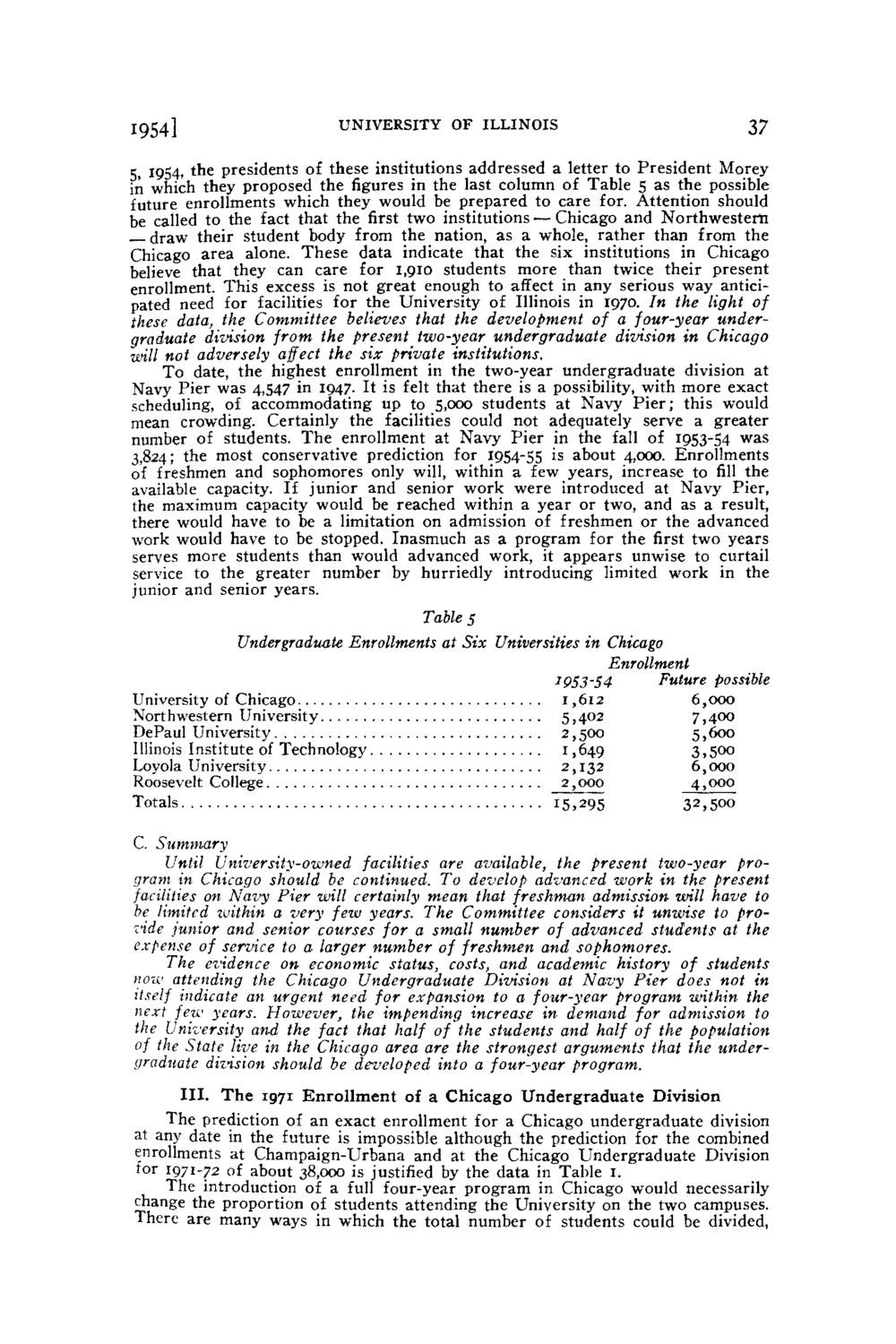| |
| |
Caption: Board of Trustees Minutes - 1956
This is a reduced-resolution page image for fast online browsing.

EXTRACTED TEXT FROM PAGE:
1954] UNIVERSITY OF ILLINOIS 37 5, 1954. t n e presidents of these institutions addressed a letter to President Morey in which they proposed the figures in the last column of Table 5 as the possible future enrollments which they would be prepared to care for. Attention should be called to the fact that the first two institutions — Chicago and Northwestern draw their student body from the nation, as a whole, rather than from the Chicago area alone. These data indicate that the six institutions in Chicago believe that they can care for 1,910 students more than twice their present enrollment. This excess is not great enough to affect in any serious way anticipated need for facilities for the University of Illinois in 1970. In the light of these data, the Committee believes that the development of a four-year undergraduate division from the present two-year undergraduate division in Chicago will not adversely affect the six private institutions. To date, the highest enrollment in the two-year undergraduate division at Navy Pier was 4,547 in 1947. It is felt that there is a possibility, with more exact scheduling, of accommodating up to 5,000 students at Navy P i e r ; this would mean crowding. Certainly the facilities could not adequately serve a greater number of students. The enrollment at Navy Pier in the fall of 1953-54 was 3,824; the most conservative prediction for 1954-55 ' s about 4,000. Enrollments of freshmen and sophomores only will, within a few years, increase to fill the available capacity. If junior and senior work were introduced at Navy Pier, the maximum capacity would be reached within a year or two, and as a result, there would have to be a limitation on admission of freshmen or the advanced work would have to be stopped. Inasmuch as a program for the first two years serves more students than would advanced work, it appears unwise to curtail service to the greater number by hurriedly introducing limited work in the junior and senior years. Table 5 Undergraduate Enrollments at Six Universities in Chicago Enrollment 1 953S4 Future possible University of Chicago 1,612 6,000 Northwestern University 5,4°2 7,4°o DePaul University 2,500 5,600 l Illinois Institute of Technology J>49 3,5°° Loyola University 2,132 6,000 Roosevelt College 2,000 4,000 Totals 15,295 3 2 ,500 Summary Until University-owned facilities are available, the present two-year program in Chicago should be continued. To develop advanced work in the present facilities on Navy Pier will certainly mean that freshman admission will have to be limited ivithin a very few years. The Committee considers it unwise to provide junior and senior courses for a small number of advanced students at the expense of service to a larger number of freshmen and sophomores. The evidence on economic status, costs, and academic history of students now attending the Chicago Undergraduate Division at Navy Pier does not in itself indicate an urgent need for expansion to a four-year program within the next few years. However, the impending increase in demand for admission to the University and the fact that half of the students and half of the population of the State live in the Chicago area are the strongest arguments that the undergraduate division should be developed into a four-year program. I I I . T h e 1971 E n r o l l m e n t of a Chicago U n d e r g r a d u a t e Division The prediction of an exact enrollment for a Chicago undergraduate division at any date in the future is impossible although the prediction for the combined enrollments at Champaign-Urbana and at the Chicago Undergraduate Division tor 1971-72 of about 38,000 is justified by the data in Table I. The introduction of a full four-year program in Chicago would necessarily change the proportion of students attending the University on the two campuses. There are many ways in which the total number of students could be divided, C.
| |